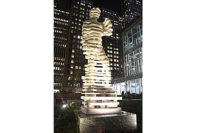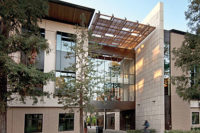
First of all, while Four Freedoms Park was just dedicated this past fall, it was actually conceived in the early 1970s. The architect was legendary Louis I. Kahn, FAIA, and he died just after finishing the drawings for the project, which was slated to be his first in New York City. In addition to Kahn’s death, financial woes by the city government caused the project to be scrapped indefinitely, and so these plans sat untouched for decades.
With the new millennium came a renewed interest in Kahn’s work, and thanks to the efforts of several influential and dedicated parties, the project broke ground in March of 2010.
The stone for the project was quarried and processed by North Carolina Granite Corp. of Mount Airy, NC, and it represents a milestone among 21st century stonework. To complete the project, the company quarried 12,100 tons of granite, and quarried material included more than 70 stones that would ultimately be cut to a size of 12 x 6 x 6 feet each. Perhaps even more impressive, these massive stone elements are separated by openings measuring only 1 inch wide.
Because the details of stonework were specified in the early 1970s, much of the work had to be cut using the methods and technology of that time. “It was really just wire saws and hand finishing,” said William Swift, President of North Carolina Granite Corp. “If you consider the sizes of the pieces, most CNCs wouldn’t be able to fit it. You don’t see a project like that today, but it was typical for the ‘50s, ‘60s and ‘70s. The smallest pieces on the job were the copings that run along the water, and they were 12 x 3 x 2.5 feet.”
To complete a project with decades-old stone detailing, the stone supplier relied on workers with decades-old experience. “Most of the guys who worked on this project were quite experienced, from 30 to 35 years each,” Swift said.
In an era where ultra-thin stonework and “touch-less” stone fabrication is promoted and celebrated, it is refreshing to be able to cover a project where the stone may as well have been processed in 1974.
Looking at the finished project — with its timeless design and awe-inspiring stonework — I find myself hoping that this is not the last time I get to cover a job like this. Maybe I am being optimistic here, but perhaps Four Freedoms Park will lay the groundwork for future projects of this magnitude.”
This hope was echoed by Swift when I interviewed him for my article. “When you have a project that has that type of mass and scale to it, it has so much more meaning,” Swift said. “If those columns were veneered, they just wouldn’t have the permanence. We are hopeful that it will inspire more projects like this.”


